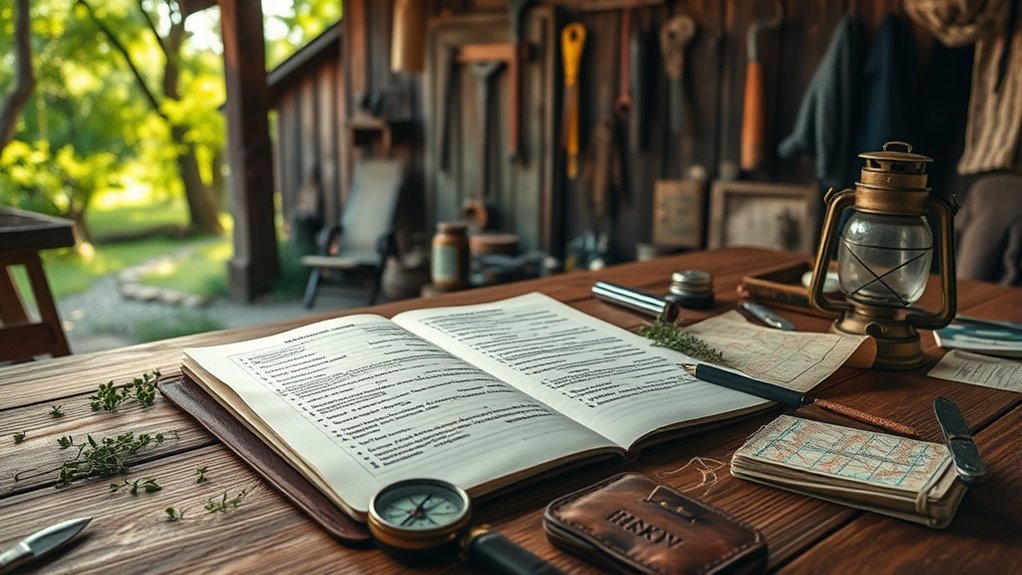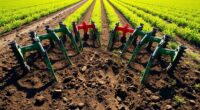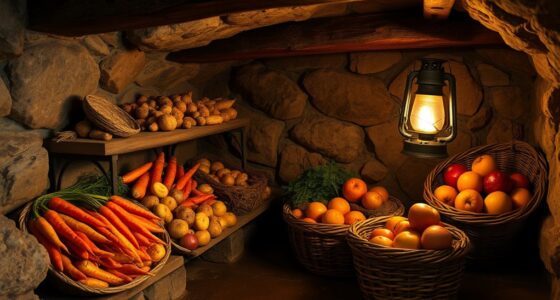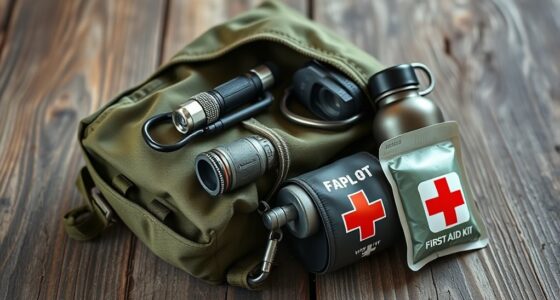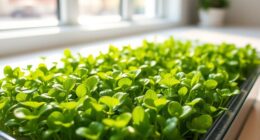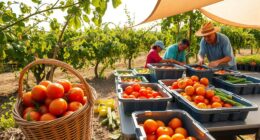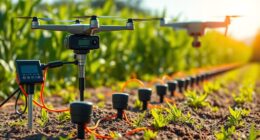To craft a survival checklist for new homesteaders, start by evaluating your basic needs like water sources, energy options, and shelter. Gather essential tools for farming, repair, and preservation, and develop food storage and preservation methods. Include water purification supplies, backup power systems, and livestock care essentials. Don’t forget first aid kits and emergency plans to guarantee safety. Keep all systems maintained and organized—your preparedness depends on it. Continuing with this guide will help you build a resilient homestead step by step.
Key Takeaways
- Assess and secure reliable water sources, storage, and purification methods for daily use and emergencies.
- Gather essential tools, equipment, and preservation supplies to ensure food security year-round.
- Develop a water management plan, including rainwater harvesting and backup purification systems.
- Stock livestock supplies, first aid kits, and backup power sources to handle emergencies effectively.
- Maintain organized systems for waste management, shelter reinforcement, and regular system inspections for resilience.
Assessing Your Homestead’s Basic Needs

Before you begin developing your homestead, determining its basic needs is essential. You need to identify what essentials are required for sustainable living. Start by evaluating your water supply—do you have reliable access or need to install rainwater collection or a well? Consider your energy sources: will you rely on solar, wind, or traditional power grids? Food production is critical, so evaluate your land’s potential for gardening, livestock, or foraging. Think about shelter requirements, ensuring structures protect you from the elements. Additionally, plan for waste management and sanitation. Understanding narcissistic behaviors helps you recognize potential manipulative tactics that could impact your planning and safety. By understanding these core needs, you create a solid foundation to build upon. This step helps you prioritize resources, avoid surprises, and lay out a clear plan for long-term survival and self-sufficiency.
Essential Tools and Equipment for Beginners
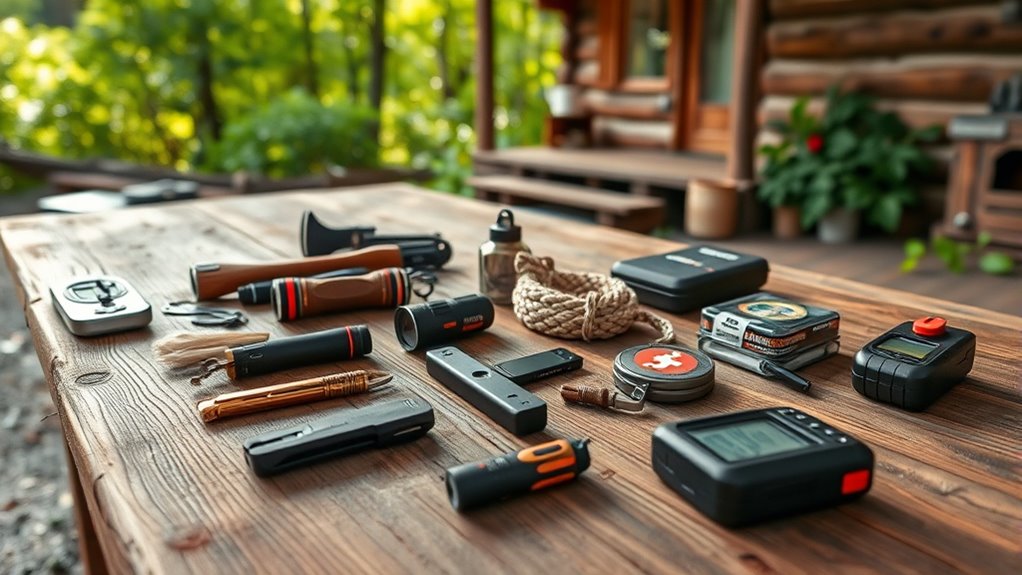
To get started, you’ll want to focus on basic hand tools that make everyday tasks easier. Securing essential food storage options guarantees your food stays safe and long-lasting, while reliable water sources are crucial for your homestead’s survival. Having these key tools and supplies in place sets a strong foundation for your homesteading journey. Additionally, understanding the importance of grocery savings strategies can help you manage your resources more effectively as you establish your new lifestyle.
Basic Hand Tools
Having the right basic hand tools is essential for any new homesteader, as they form the foundation for everyday tasks around your property. A sturdy hammer is crucial for framing, repairs, and building projects. A set of screwdrivers, both flathead and Phillips, helps with assembling equipment and fixing things. A good pair of pruning shears makes trimming plants and bushes easier, while a handsaw is perfect for cutting wood when necessary. A wrench or adjustable pliers are useful for tightening bolts and nuts. Don’t forget a level and tape measure for accurate work. Keep a set of chisels, a utility knife, and gloves handy for detailed tasks. These tools make routine chores more efficient, reliable, and help you build your homestead with confidence. Additionally, ensuring your tools are properly maintained can extend their lifespan and improve safety during use.
Essential Food Storage
Equipping yourself with the right tools and equipment is vital for managing food storage effectively on your homestead. Start with sturdy, airtight containers to keep out pests and moisture, preserving your harvest longer. Mason jars are versatile for canning fruits and vegetables, while plastic bins provide organized storage for grains, beans, and dried goods. A reliable vacuum sealer helps extend shelf life of bulk foods, reducing waste. Consider a digital scale for precise measurements during preservation processes. Shelving units should be durable and adjustable, maximizing storage space. Labels are indispensable for tracking expiration dates and contents. Additionally, invest in a thermometer to monitor storage temperatures and guarantee ideal conditions. Proper tools and equipment streamline food storage, keeping your food safe, fresh, and ready for emergencies.
Reliable Water Sources
Securing a reliable water source is essential for a successful homestead, especially in emergencies. You need consistent access to clean water for drinking, cooking, and sanitation. Consider installing a well or setting up rainwater harvesting systems. Having backup options guarantees you stay prepared during droughts or system failures. Equip yourself with a sturdy water pump, storage tanks, and filtration units to maintain water quality. Here’s a quick overview:
| Tool/Equipment | Purpose |
|---|---|
| Hand Pump | Draw water manually |
| Water Filtration System | Purify water for safe use |
| Storage Tanks | Store water for emergencies |
| Rainwater Harvesting | Collect and utilize rainwater |
These tools form the backbone of a dependable water supply on your homestead.
Water Management and Purification Supplies
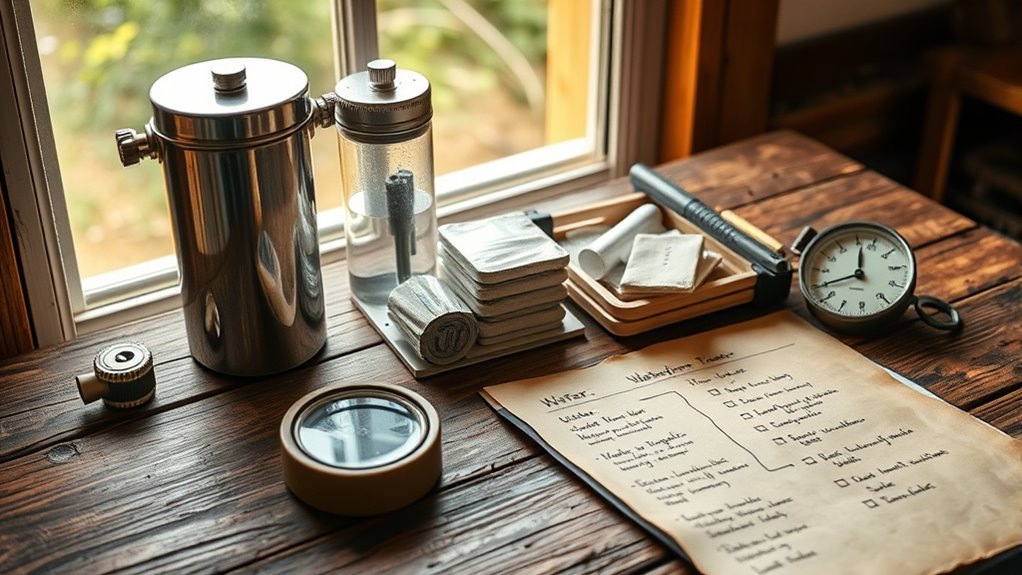
You need reliable water storage solutions to guarantee you have enough for daily use and emergencies. Purification devices and methods are vital for making water safe to drink, especially when access is limited. It’s also wise to stock emergency water supplies to prepare for unexpected disruptions. Incorporating water purification methods such as filtration or boiling can effectively eliminate contaminants and pathogens from questionable water sources.
Water Storage Solutions
Effective water storage is essential for ensuring a reliable supply during emergencies or daily needs. You should choose sturdy containers made from food-grade materials, such as polyethylene or glass, to prevent contamination. Store water in a cool, dark place to inhibit algae growth and deterioration. Consider using large rain barrels connected to your gutter system for easy collection, and keep smaller bottles for portability. Regularly inspect your containers for leaks or cracks, and keep lids tightly sealed to prevent debris and pests. Label containers clearly and rotate stored water every six months to maintain freshness. Proper water treatment methods can further ensure the safety and potability of your stored water. By investing in reliable storage solutions, you ensure access to clean water when it’s most needed, supporting your homestead’s resilience and preparedness.
Purification Methods and Devices
Once you’ve stored your water properly, it’s important to guarantee it’s safe for consumption. You can do this by using purification methods like boiling, which kills most pathogens, or chemical treatments such as iodine or chlorine tablets. Filtration devices, like portable water filters or pump filters, remove debris, bacteria, and protozoa, making water safer to drink. UV purifiers are also effective; they use ultraviolet light to destroy microorganisms. Always choose reliable devices suited for your needs and ensure they’re easy to operate and maintain. Having multiple purification options provides redundancy in case one fails. Keep your supplies organized and readily accessible, so you can quickly purify water when needed. Proper purification safeguards your health and guarantees your water remains safe during emergencies. Remember that understanding various purification techniques can enhance your ability to keep water safe in different situations.
Emergency Water Supplies
Are you prepared to manage your emergency water supplies effectively? Ensuring you have enough clean water is essential for survival. Store several gallons of water in sturdy containers, rotating them regularly. Consider portable filters and purification tablets for on-the-go solutions. Keep a detailed list of supplies to track your inventory. Regularly inspecting your water purification equipment ensures it remains in good working order.
Here’s a quick guide to essential water management tools:
| Item | Purpose | Storage Tips |
|---|---|---|
| Water Storage Bins | Hold large water quantities | Keep in a cool, dark place |
| Portable Filters | Purify water from natural sources | Clean and replace filters as needed |
| Purification Tablets | Kill bacteria and viruses | Store in a waterproof container |
Being prepared means staying adaptable and vigilant about your water needs.
Food Preservation and Storage Resources
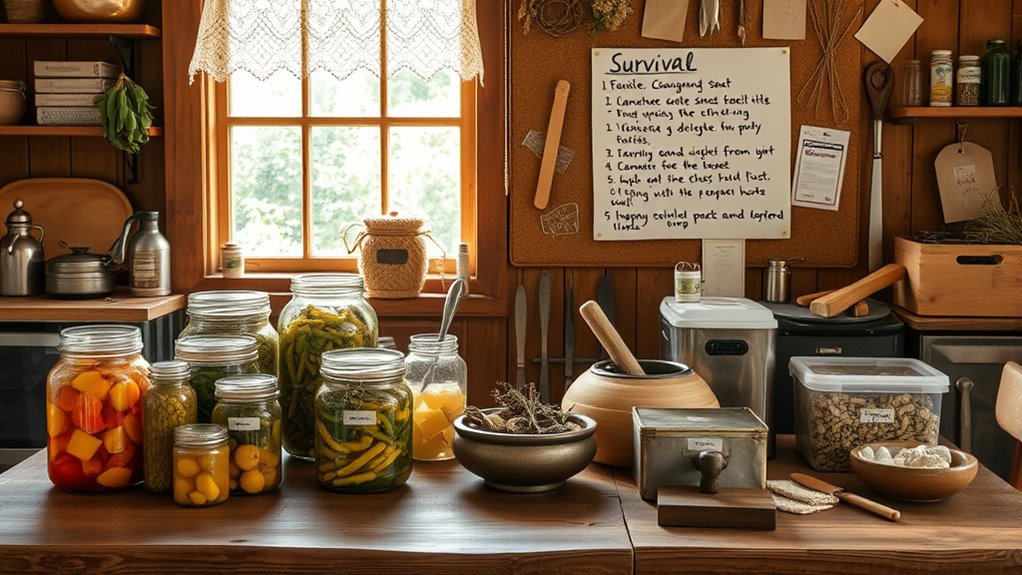
Have you considered the essential resources and techniques needed to preserve and store your food effectively? Proper preservation ensures your harvest lasts through lean times, reducing waste and increasing self-sufficiency. Investing in reliable tools and methods is crucial for long-term success. You’ll want supplies like canning jars and lids to safely preserve fruits and vegetables. Freezers are vital for extending storage life, especially for bulk items. Drying racks or dehydrators help preserve herbs and produce efficiently. Proper storage containers and cool, dark spaces prevent spoilage and pests, maintaining food quality. Using food preservation methods can further enhance your ability to store and enjoy your harvest throughout the year. With these resources, you can confidently preserve your harvest, reduce food waste, and ensure a steady food supply year-round.
Livestock Care and Management Items
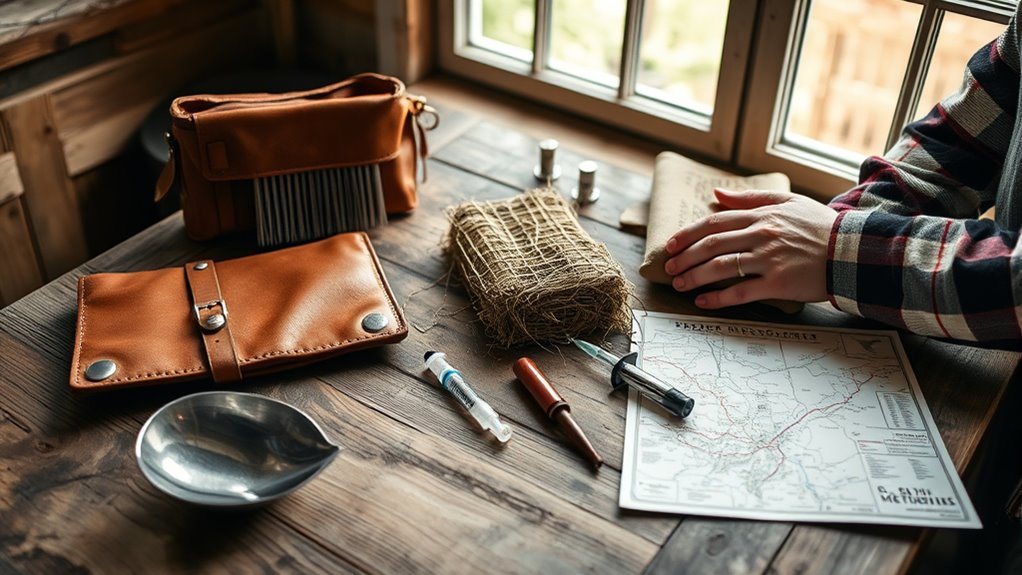
Proper livestock care begins with having the right management items on hand, ensuring your animals stay healthy and productive. Stock up on feed and water containers to maintain proper hydration and nutrition. Keep grooming supplies like brushes, hoof trimmers, and insecticides to prevent infections and pests. Essential tools include fencing materials to secure your animals and prevent escapes, as well as bedding materials for comfort and hygiene. Regularly check and store medications such as vitamins and parasite control products to promote health. Having a reliable supply of cleaning supplies will help maintain a sanitary environment, reducing disease risk. Additionally, keep records of animal health, breeding, and treatments to monitor progress and plan future care effectively. Proper management items are key to a thriving, sustainable homestead. Maintaining livestock health through proper nutrition and disease prevention is also vital for a productive homestead.
First Aid and Emergency Medical Supplies
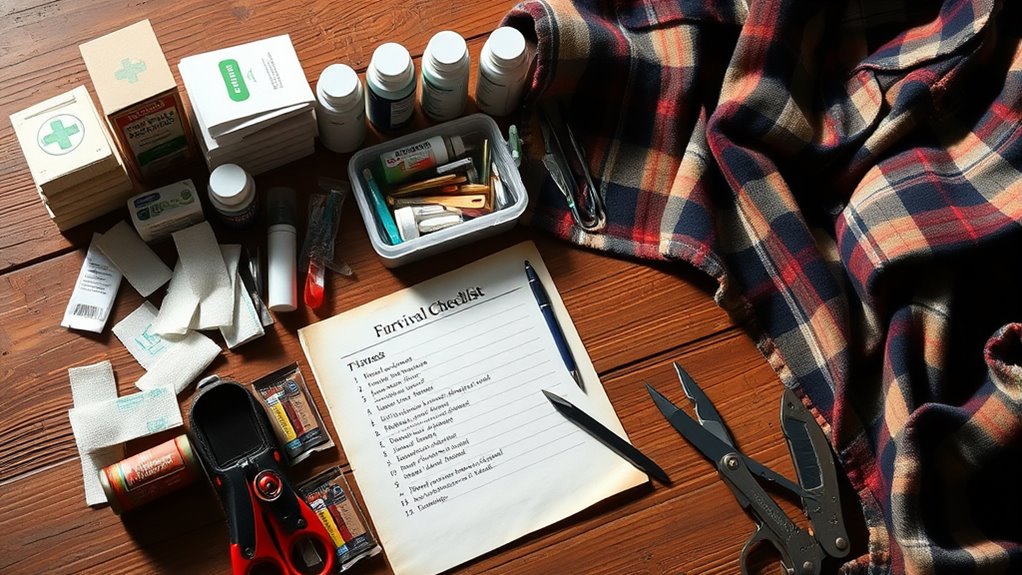
Being prepared for emergencies starts with assembling a well-stocked first aid kit tailored to your homestead’s needs. You should include supplies to treat common injuries and address medical issues until professional help is available. Focus on items that cover cuts, burns, bites, and sprains. Regularly check and restock supplies to ensure everything is in date and ready to use. Keep your kit in an accessible location known to everyone on your property. Consider adding personalized items like medications or specific tools for your family’s needs. Remember, quick access and proper supplies can make a significant difference in emergency situations. Additionally, understanding first aid procedures and basic medical response can greatly improve outcomes during emergencies.
Power and Shelter Backup Systems
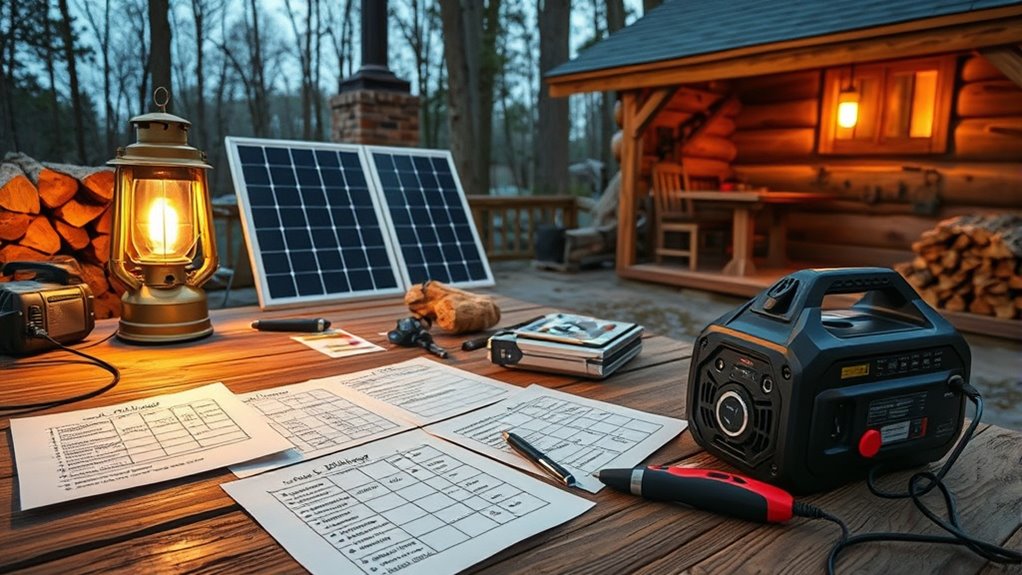
To guarantee your homestead remains functional during power outages or extreme weather, setting up reliable backup systems for power and shelter is essential. You need options like solar panels, generators, and battery storage to stay connected and safe. For shelter, consider reinforced structures, storm shutters, and insulation to withstand harsh conditions. These systems ensure you’re not left vulnerable when disaster strikes.
| Power Backup | Shelter Reinforcement |
|---|---|
| Solar panels for sunlight | Reinforced walls for storms |
| Portable generators for emergencies | Storm shutters to protect windows |
| Battery storage for consistent power | Insulation to retain heat or coolness |
| Manual tools for basic needs | Emergency shelter options |
Skills and Knowledge to Develop for Self-Reliance
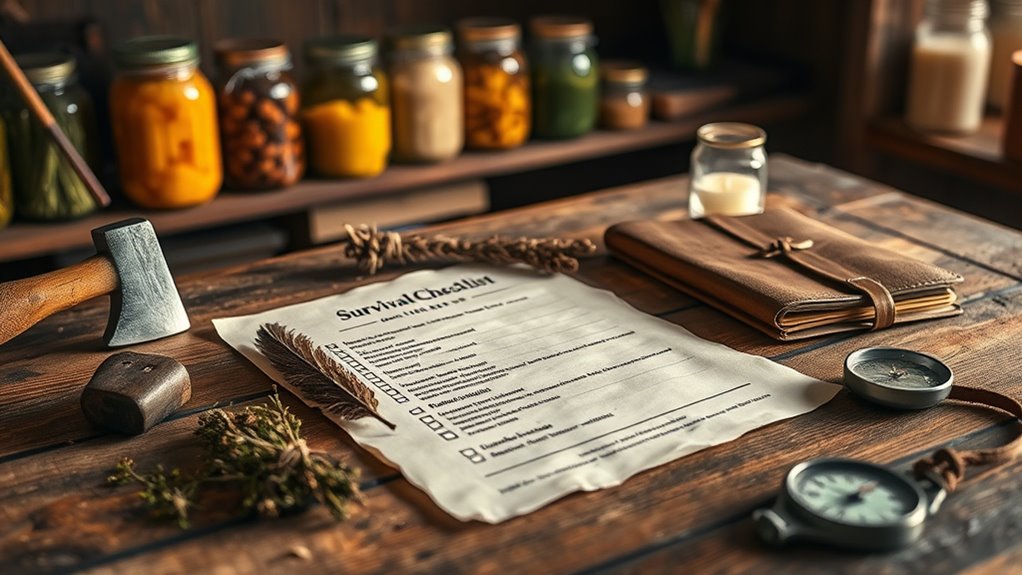
Developing essential skills and knowledge is crucial for achieving true self-reliance on your homestead. By mastering key areas, you’ll reduce dependence on outside resources and handle challenges confidently. Focus on practical skills that keep you prepared for various situations. For example, learning how to grow and preserve your own food ensures a steady supply during shortages. Understanding basic first aid allows you to treat injuries promptly. Additionally, developing skills in carpentry and repairs helps you maintain your shelter and tools without waiting for external help. These skills create a resilient homestead that can adapt to unforeseen circumstances. Investing time in these areas builds confidence, saves money, and creates a sustainable lifestyle tailored to your needs.
Frequently Asked Questions
How Do I Prioritize My Emergency Supplies for Different Seasons?
You should prioritize emergency supplies based on seasonal needs. In winter, focus on heating, warm clothing, and insulation. Spring and summer require water purification, pest control, and cooling solutions. Fall calls for prepping for storms, extra food, and backup power. Keep versatile, non-perishable items accessible year-round, but tailor your supplies to the upcoming season’s challenges. Regularly review and adjust your checklist to stay prepared for changing weather conditions.
What Safety Measures Should I Implement for Livestock Handling?
You should always guarantee your livestock are secure and comfortable. Use proper fencing and gates to prevent escapes, and handle animals calmly to reduce stress. Regularly check for signs of illness or injury, and keep a first aid kit nearby. Train yourself in safe handling techniques, and avoid sudden movements. Additionally, establish clear protocols for emergency situations, like predator threats or extreme weather, to protect both your animals and yourself.
How Can I Conserve Water Effectively During Droughts?
During droughts, you should prioritize water conservation by installing rain barrels to collect runoff, fixing leaks promptly, and using mulches around plants to reduce evaporation. Opt for drought-tolerant crops and water early in the morning or late evening to minimize loss. Reusing greywater for irrigation and limiting non-essential water use also help. These steps guarantee you maximize your water supply and sustain your homestead during dry periods.
Which Renewable Energy Options Are Most Feasible for Homesteads?
You can harness solar power, wind energy, and micro-hydro systems for your homestead. Solar panels are highly feasible, providing reliable, maintenance-free energy during sunny days. Wind turbines work well if you live in a breezy area, generating power consistently. Micro-hydro systems tap into nearby streams or rivers, offering a steady energy source. Combining these options maximizes sustainability and resilience, ensuring your homestead remains self-sufficient and eco-friendly.
How Do I Train Myself in First Aid for Remote Locations?
You should start by taking a certified first aid course, focusing on trauma, burns, and CPR, preferably one tailored for remote settings. Practice regularly with a first aid kit to build confidence. Consider online courses and instructional videos for ongoing learning. Keep a manual handy, and join local or online homesteading groups for tips. Staying proactive guarantees you’re prepared to handle emergencies confidently in remote locations.
Conclusion
By following this survival checklist, you’ll be well on your way to building a resilient homestead. Staying prepared is key to weathering any storm, so keep learning and adapting as you go. Remember, a stitch in time saves nine—address small issues before they become big problems. With the right tools, knowledge, and mindset, you’ll turn your homestead into a thriving oasis, proving that preparedness really is half the battle won.

